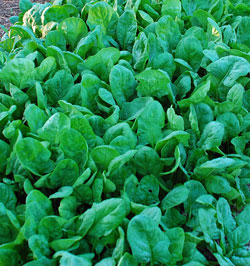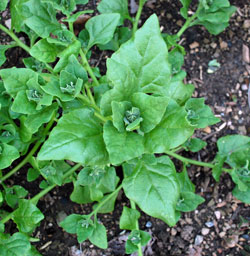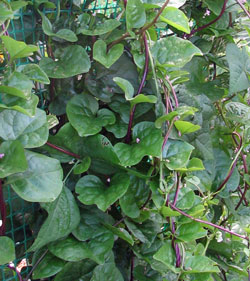Spinach
 ©Janet AllenBed of spinach
©Janet AllenBed of spinach We wish we could always achieve such a thriving bed of spinach. Some years it happens; some years it doesn't. This particular year we were able to harvest and freeze enough spinach that we could have some throughout the winter.
I cut the spinach back to two or three inches high and let it regrow one or two times.
This spinach grew in 2010 from new seed. We harvested twenty-one pounds of spinach. The next year we harvested almost no spinach—less than two pounds. Planting several times during the year didn't help. While other people also had a poor spinach harvest it seems that part of our problem was seed viability. We planted some of the same seed early in 2012 and three four foot rows of spinach produced two plants. Some weeks later when we planted separate rows of this seed and two other new packets of seeds nothing emerged while the other two rows grew quite nicely. While some vegetable seeds (tomatoes being a prominent one) are good for years, this is not true of all vegetables. It pays to buy new seeds every year.
 ©Janet AllenAn older spinach plant
©Janet AllenAn older spinach plant Spinach is a cool weather crop. When summer kicks in the plants begin to "bolt." That is they begin to go to seed. The center of the plant starts to grow tall and flowers form. The plant's energy goes toward seed production and, in terms of the eater, the leaves start to become bitter.
 ©Janet AllenClimbing spinach
©Janet AllenClimbing spinach This is Red Malabar spinach. It is not really spinach but substitutes for it in warm weather. This plant needs to climb and was very productive. Some people do not like the fact that the thick leaves have a slimy feel after it is cooked. An even more spinach-like plant is New Zealand spinach, also a warm weather green.
Harvest record
| YR | LB | Notes |
| 15 | ||
| 14 | 2 | |
| 13 | 3 | |
| 12 | 2 | |
| 11 | 2 | |
| 10 | 21 | Not a typo! Just an usually good spring for spinach. |
| 09 | 6 |
